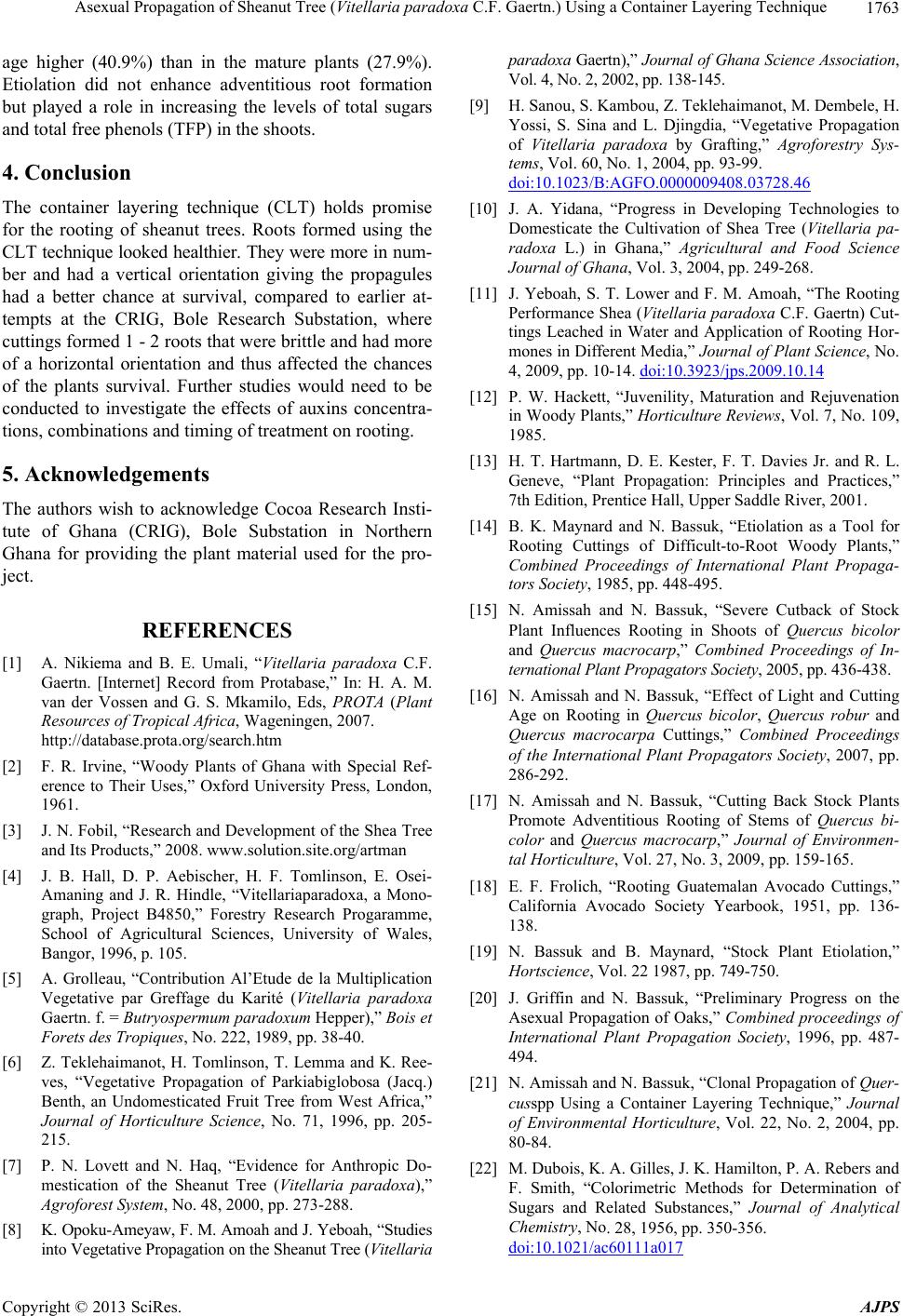
Asexual Propagation of Sheanut Tree (Vitellaria paradoxa C.F. Gaertn.) Using a Container Layering Technique 1763
age higher (40.9%) than in the mature plants (27.9%).
Etiolation did not enhance adventitious root formation
but played a role in increasing the levels of total sugars
and total free phenols (TFP) in the shoots.
4. Conclusion
The container layering technique (CLT) holds promise
for the rooting of sheanut trees. Roots formed using the
CLT technique looked healthier. They were more in nu m-
ber and had a vertical orientation giving the propagules
had a better chance at survival, compared to earlier at-
tempts at the CRIG, Bole Research Substation, where
cuttings formed 1 - 2 roots that were b rittle and h ad more
of a horizontal orientation and thus affected the chances
of the plants survival. Further studies would need to be
conducted to investigate the effects of auxins concentra-
tions, combinations and timing of treatment on rooting.
5. Acknowledgements
The authors wish to acknowledge Cocoa Research Insti-
tute of Ghana (CRIG), Bole Substation in Northern
Ghana for providing the plant material used for the pro-
ject.
REFERENCES
[1] A. Nikiema and B. E. Umali, “Vitellaria paradoxa C.F.
Gaertn. [Internet] Record from Protabase,” In: H. A. M.
van der Vossen and G. S. Mkamilo, Eds, PROTA (Plant
Resources of Tropical Africa, Wageningen, 2007.
http://database.prota.org/search.htm
[2] F. R. Irvine, “Woody Plants of Ghana with Special Ref-
erence to Their Uses,” Oxford University Press, London,
1961.
[3] J. N. Fobil, “Research and Development of the Shea Tree
and Its Products,” 2008. www.solution.site.org/artman
[4] J. B. Hall, D. P. Aebischer, H. F. Tomlinson, E. Osei-
Amaning and J. R. Hindle, “Vitellariaparadoxa, a Mono-
graph, Project B4850,” Forestry Research Progaramme,
School of Agricultural Sciences, University of Wales,
Bangor, 1996, p. 105.
[5] A. Grolleau, “Contribution Al’Etude de la Multiplication
Vegetative par Greffage du Karité (Vitellaria paradoxa
Gaertn. f. = Butryospermum paradoxum Hepper),” Bois et
Forets des Tropiques, No. 222, 1989, pp. 38-40.
[6] Z. Teklehaimanot, H. Tomlinson, T. Lemma and K. Ree-
ves, “Vegetative Propagation of Parkiabiglobosa (Jacq.)
Benth, an Undomesticated Fruit Tree from West Africa,”
Journal of Horticulture Science, No. 71, 1996, pp. 205-
215.
[7] P. N. Lovett and N. Haq, “Evidence for Anthropic Do-
mestication of the Sheanut Tree (Vitellaria paradoxa),”
Agroforest System, No. 48, 2000, pp. 273-288.
[8] K. Opoku-Ameyaw, F. M. Amoah and J. Yeboah, “Studies
into Vegetative Propagation on the Sheanut Tree (Vitellaria
paradoxa Gaertn),” Journal of Ghana Science Association,
Vol. 4, No. 2, 2002, pp. 138-145.
[9] H. Sanou, S. Kambou, Z. Teklehaimanot, M. Dembele, H.
Yossi, S. Sina and L. Djingdia, “Vegetative Propagation
of Vitellaria paradoxa by Grafting,” Agroforestry Sys-
tems, Vol. 60, No. 1, 2004, pp. 93-99.
doi:10.1023/B:AGFO.0000009408.03728.46
[10] J. A. Yidana, “Progress in Developing Technologies to
Domesticate the Cultivation of Shea Tree (Vitellaria pa-
radoxa L.) in Ghana,” Agricultural and Food Science
Journal of Ghana, Vol. 3, 2004, pp. 249-268.
[11] J. Yeboah, S. T. Lower and F. M. Amoah, “The Rooting
Performance Shea (Vitellaria paradoxa C.F. Gaertn) Cut-
tings Leached in Water and Application of Rooting Hor-
mones in Different Media,” Journal of Plant Science, No.
4, 2009, pp. 10-14. doi:10.3923/jps.2009.10.14
[12] P. W. Hackett, “Juvenility, Maturation and Rejuvenation
in Woody Plants,” Horticulture Reviews, Vol. 7, No. 109,
1985.
[13] H. T. Hartmann, D. E. Kester, F. T. Davies Jr. and R. L.
Geneve, “Plant Propagation: Principles and Practices,”
7th Edition, Prentice Hall, Upper Saddle River, 2001.
[14] B. K. Maynard and N. Bassuk, “Etiolation as a Tool for
Rooting Cuttings of Difficult-to-Root Woody Plants,”
Combined Proceedings of International Plant Propaga-
tors Society, 1985, pp. 448-495.
[15] N. Amissah and N. Bassuk, “Severe Cutback of Stock
Plant Influences Rooting in Shoots of Quercus bicolor
and Quercus macrocarp,” Combined Proceedings of In-
ternational Plant Propagators Society, 2005, pp. 436-438.
[16] N. Amissah and N. Bassuk, “Effect of Light and Cutting
Age on Rooting in Quercus bicolor, Quercus robur and
Quercus macrocarpa Cuttings,” Combined Proceedings
of the International Plant Propagators Society, 2007, pp.
286-292.
[17] N. Amissah and N. Bassuk, “Cutting Back Stock Plants
Promote Adventitious Rooting of Stems of Quercus bi-
color and Quercus macrocarp,” Journal of Environmen-
tal Horticulture, Vol. 27, No. 3, 2009, pp. 159-165.
[18] E. F. Frolich, “Rooting Guatemalan Avocado Cuttings,”
California Avocado Society Yearbook, 1951, pp. 136-
138.
[19] N. Bassuk and B. Maynard, “Stock Plant Etiolation,”
Hortscience, Vol. 22 1987, pp. 749-750.
[20] J. Griffin and N. Bassuk, “Preliminary Progress on the
Asexual Propagation of Oaks,” Combined proceedings of
International Plant Propagation Society, 1996, pp. 487-
494.
[21] N. Amissah and N. Bassuk, “Clonal Propagation of Quer-
cusspp Using a Container Layering Technique,” Journal
of Environmental Horticulture, Vol. 22, No. 2, 2004, pp.
80-84.
[22] M. Dubois, K. A. Gilles, J. K. Hamilton, P. A. Rebers and
F. Smith, “Colorimetric Methods for Determination of
Sugars and Related Substances,” Journal of Analytical
Chemistry, No. 28, 1956, pp. 350-356.
doi:10.1021/ac60111a017
Copyright © 2013 SciRes. AJPS